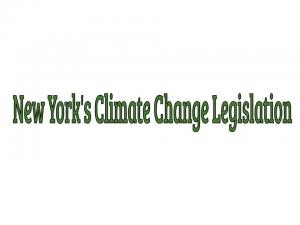- 34 reads

During the past few months, legislators of New York have developed and passed multiple acts in attempts to address climate change and significantly reduce their state’s contributions to pollution and carbon emissions. These acts have collectively been referred to as “New York’s Green New Deal” and have been strongly advocated for by Mayor Bill de Blasio. The state’s efforts to enforce reduction laws on carbon emissions take a multi-pronged approach, targeting large commercial buildings, reforming the transportation industry, promoting energy efficient practices, and funding clean energy research and development, farming, and forestry. New York government officials including de Blasio and Gov. Andrew Cuomo have stated that their rigorous approach and stringent policies are enacted with the goal of reaching statewide net-zero greenhouse gas emissions by 2050. Some have referred to these policies as ambitious and progressive, while critics call it aggressive and flawed. Although some argue that the costs of these new plans and the competition they will bring is excessive and will lead to overall negative effects, de Blasio has justified his stance saying "I can't think of anything better to spend money on than saving the Earth." Let’s take a deeper look into the major components of the new policies.
In April, de Blasio announced New York’s Green New Deal which will work in tandem with the Climate Mobilization Act (CMA) to source “100% clean electricity” by 2050, while applying strict regulations on large commercial buildings to reduce carbon emissions in the short-run. The main piece of the CMA is an emissions cap on buildings over 25,000 square feet (barring some exceptions) incentivizing building owners to retrofit their properties or pay large fines. De Blasio also announced a ban on the construction of energy inefficient glass structures, and a shift to hydropower for government buildings. The legislation focuses on large buildings because their greenhouse gas emissions account for about 70% of the state’s total emissions. Policy-makers are turning to green roofing, wind turbine installation, hydropower, clean energy assessments, and renewable energy R&D to try and meet the proposed goal. The CMA has been called
the most ambitious energy efficiency legislation in the country.
More recently, Gov. Andrew Cuomo has stated his intent to sign the Climate Leadership and Community Protection Act to enforce the statewide goal to reach net-zero greenhouse emissions by 2050. In order to achieve this goal, the Act details that there will be enforced measures and regulations to cut the state’s total carbon emissions by 85% by 2050. To achieve net-zero emissions, the other 15% will be covered through reforestation, nature restoration, carbon capturing, and other projects to replenish the environment. New York already produces about 60% of its electricity from carbon-free sources (New York Times) and the new Act is pushing to increase that amount to at least 70% by 2030 through renewable wind or hydro energy. The state plans to build wind turbines, invest in rooftop solar panels, and retrofit buildings that normally run on high amounts of fossil fuels. The bill also works to protect and improve conditions in low-income communities that are greatly affected by pollution by requiring 35% of clean-energy funds to be focused towards them. According to Democrat and Chronicle, “Much of how the state decides to implement any mandates or regulations to hit its goals will be guided by a new, 22-member state panel: The New York State Climate Action Council.”
As the bills and legislation detail, government officials are highly focused on reducing greenhouse gas emissions through renewable energy sources. Yet, critics have correctly pointed out that this method on its own is quite costly and can lead to unintended economic consequences such as harmful competition between businesses. It is actually much less expensive and more feasible in the short-run to reduce energy inefficiency through clean energy technology, rather than solely turning to alternative power sources. Sustainable and cost-effective solutions to address carbon emissions lie in cleantech initiatives that address commercial cooling, energy-efficient lighting, and indoor agriculture. New York officials state that they are taking “measures meant to spur worker training in the clean-energy industry” (Democrat and Chronicle). While this is a noble effort, they are overlooking technology with proven results already present in the clean-energy industry.
For more information on proven cleantech solutions:
See: Commercial Air Conditioning Optimization Case Studies
See: Energy Efficient LED Lighting Case Studies
See: The Future of Food: Indoor Agriculture
Some information in this article comes from:
https://www.nytimes.com/2019/06/18/nyregion/greenhouse-gases-ny.html
https://gothamist.com/2019/04/22/de_blasio_nyc_climate_change.php

